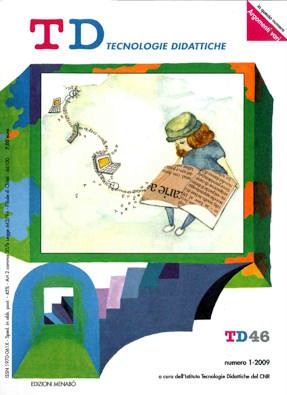Progettare e gestire percorsi e-learning ispirandosi al modello Learner Centered
Contenuto principale dell'articolo
Abstract
Dettagli dell'articolo
Gli autori che pubblicano su questa rivista accettano le seguenti condizioni:
- Gli autori mantengono i diritti sulla loro opera e cedono alla rivista il diritto di prima pubblicazione dell'opera, contemporaneamente licenziata sotto una Licenza Creative Commons CC BY 4.0 Attribution 4.0 International License.
- Gli autori possono aderire ad altri accordi di licenza non esclusiva per la distribuzione della versione dell'opera pubblicata (es. depositarla in un archivio istituzionale o pubblicarla in una monografia), a patto di indicare che la prima pubblicazione è avvenuta su questa rivista.
- Gli autori possono diffondere la loro opera online (es. in repository istituzionali o nel loro sito web) prima e durante il processo di submission, poiché può portare a scambi produttivi e aumentare le citazioni dell'opera pubblicata (Vedi The effect of Open Access).
Riferimenti bibliografici
Andrews D.H., Goodson L.A. (1980), A comparative analysis of instructional design, Journal of Instructional Development, vol. 3, n. 4, pp.70-90.
APA Task Force on Psychology in Education (1993), Learner-centered psychological principles: Guidelines for school redesign and reform, American Psychological Association and Mid-Continent Regional Educational Laboratory, Washington, DC.
APA Work Group of the Board of Educational Affairs, (1997), Learner-centered psychological principles: A framework for school reform and redesign, American Psychological Association, Washington, DC.
Barak M. (2006), Instructional principles for fostering learning with ICT: teachers’ perspectives as learners and instructors, Education and Information Technologies, n.11, pp.121-135.
Benigno V., Trentin G. (2000), An approach to the evaluation of online courses, International Journal of computer Assisted Learning, vol. 16, n.3, pp.259-270.
Benigno V., Vallarino E. (2007), Authentic Assessment: An Evaluation Methodology for E-Learning, in Nunes M.B., McPherson M. (eds) Proceeding of IADIS International Conference Proceeding, E-Learning 2007, vol. 1, IADIS Press, Lisbon, Portugal, pp.459-466.
Benigno V., Chifari A. (2007), Strategie per promuovere la presenza sociale in gruppi di apprendimento online, TD-Tecnologie Didattiche, vol. 3, n. 42, Edizioni Menabò, Ortona (CH), pp.40-50.
Benigno V., Vallarino E. (2009), L’e-learning nella formazione dei docenti ospedalieri: il caso HSH@Teacher in Piave N. (ed.) Nuove Frontiere Pedagogiche, Barbieri Editore srl, Manduria TA.
Damasio A. (1996), Descartes’s Error: Emotion, Reason, and the Human Brain, Papermac, London.
Gagné R. M. (1973), Le condizioni dell’apprendimento, Armando, Roma.
Hadji C. (1995), La valutazione delle azioni educative, La Scuola, Brescia.
Hannum W.H., McCombs B.L. (2008), Enhancing distance learning with learnercentered principles, Educational Technology, vol. 48, n. 4, pp.11-21.
Hannum W.H., Irvin J.M., Lei P.W., Farmer T.W. (2008), Effectiveness of using learnercentered principles on student retention in distance education courses in rural schools, Distance Education, vol. 29, n. 3, pp.211-229.
Holzinger A., Motschig-Pitrik R. (2005), Considering the Human in Multimedia: Learner- Centered Design (LCD) & Person-Centered e-Learning (PCeL). http://user.meduni-graz.at/andreas.holzingerholzinger/ papers%20en/L32Reading.pdf [consultazione giugno 2009]
Jonassen D.H. (1994), Thinking technology, toward a constructivist design model, Educational Technology, n. 34, pp.34-37.
LeDoux J. (1999), The Emotional Brain: The Mysterious Underpinnings of Emotional Life, Phoenix, London.
Mason R. (2002), Review of E-learning for Education and Training, in Proceedings third Networked Learning Conference 26-28 Marzo 2002, University of Sheffield, UK. www.networkedlearningconference.org.uk/pa st/nlc2002/proceedings/symp/02.htm#02a [consultazione giugno 2009]
McCombs B.L., Vakili D. (2005), A learnercentered framework for e-learning, Teachers College Record, vol. 107, n. 8, pp.1582- 1609.
OCSE (2005), E-learning in Tertiary Education. Where do we stand?, OECD Publishing Centre for Educational Research and Innovation, London UK.
Penna A.M., Stara V. (2006), Valutare l’Elearning secondo i principi LCD (Learner Centered Design), in ISDM (eds) Proceeding of Tice Mediterranée annual conference 2006 , Genova. http://isdm.univ-tln.fr/PDF/isdm25/ PennaStara_TICE2006.pdf [consultazione giugno 2009]
Romiszowski, A.J. (2004), How’s the e-elarning Baby? Factor Leading to Success or Failure of an Rducational Technology Innovation, Educational Technology, vol. 44, n. 1, pp.5-27.
Roblyer M.D. (2006), Virtually successful: Defeating the dropout problem through online school Programs, Phi Delta Kappa, vol. 88, pp.31-36.
Rovai A.P., Wighting M.J. (2005), Feelings of alienation and community among higher education students in a virtual community, The Internet and Higher Education, vol. 8, n.2, pp.97-110.
Simpson O. (2004), The impact on retention of interventions to support distance learning, Open Learning, vol. 19. N. 1, pp.79-96.
Tallent-Runnels M.K., Thomas J.A., Lan W.Y., Cooper S., Ahern T.C., Shaw S.M. (2006), Teaching courses online: A review of the research., Review of Educational Research, vol.76, n. 1, pp.93-135.
Trentin G. (2008), La sostenibilità didatticoformativa dell’E-learning, Franco Angeli, Milano.
Vygotskij L.S. (1978), Mind in Society, Cambridge, Massachusetts, Harvard University Press (trad. it.: Il Processo Cognitivo, Torino, Boringhieri,1978).
Zhao Y., Lei J., Yan B., Lai C., Tan H. (2005), What makes the difference? A practical analysis of research on the effectiveness of distance education, Teachers College Record, vol.107, n. 8, pp.1836-1884.
Woodill G. (2004), Where is the learning in E-learning?, Operitel corporation, Ontario, Canada. http://www.e-learningguru.com/ wpapers/e-Learning_analysis.pdf [consultazione giugno 2009]
Worthen B.R., White K.R., Fan X., Sudweeks R.R. (1999), Measurement and Assessment in Schools, Longman, New York.

